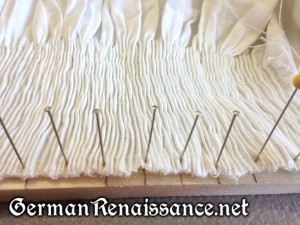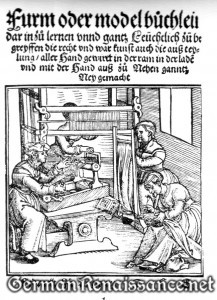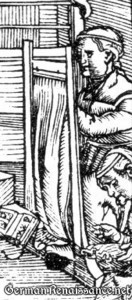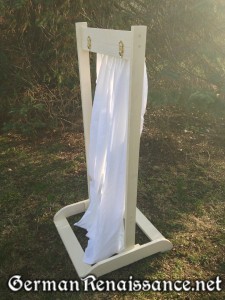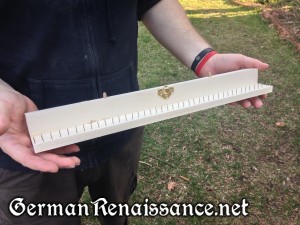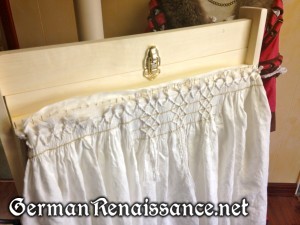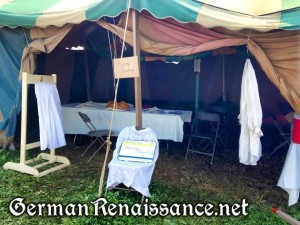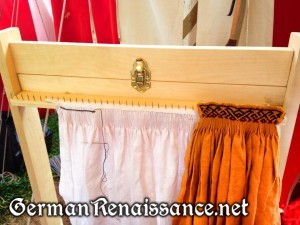Necessity really is the mother of invention. Or in this case, maybe a re-invention. When I was working on the Dorothea Meyer hemd earlier this year, I reached a point where I was pinning the pleated linen to a board, like this:
Pinning it allowed me to position each set of pleats the proper distance from each other, which was really important in achieving Dorothea’s hemd design. Once they were pinned, I realized I needed to get to the pleats from the OTHER side (the pins were in my way), and it would be ever so helpful if the pleated linen just sort of hung there, allowing me to view the drape of the fabric as well. I turned the linen around and tried to hang it off a wooden box I had, when suddenly this image appeared in my head:
Here’s a closer look:
This image is from Furm oder model büchlein, a 16th century modelbook. I and others have long thought that the woman was using it for some sort of pleatwork, based on the way the fabric appears to be pleated at the top and how it drapes on the frame. I hadn’t been sure how it would work, but now I had an idea based on a real need.
So I asked my partner Gregor to build me a frame based on my specifications. I wanted it to be wide enough that a pleated ell of fabric would fit neatly in it, I wanted the bar of the frame to be about eye-level when seated, and I wanted the bar to be removable for positioning and storage. Here’s what he made me:
The top bar unbuckles to allow it to come off completely:
The bar has brass nails which Gregor filed down so they were smooth like pins.
I then used the pleating frame to hold my hemd while I worked on it the front section, and it worked well. I didn’t overtension the stitches and I could see how the linen and cords flowed.
I brought the frame to Pennsic these last two weeks (it comes apart to pack flat) and had it on Artisan’s Row for Pleatwork/Smocking.
The frame made it very easy for people to try their hand at pleatwork, too. Here’s a practice pleated piece I whipped up while at Pennsic (the white linen) besides a piece I worked on without the frame that suffers from tension issues (the gold linen).
Is it how 16th c. Germans would have used a tool like this? I am not sure without having more information, such as more illustrations or accounts of use of similar tools. I can only say it is working well for me so far.
That said, I think it is possible that the business end of the frame looked and worked differently. I can envision rows of movable pins that allow one to place linen on and then slide along a track to effectively fold and pleat the material for stitching. The problem with that idea is that it would require a longer frame in order to pleat even a moderate amount of fabric, so I’m not so sure it makes sense. If I come up with an idea on how to do it, however, I will try it! If anyone out there has an idea, please share it here.
